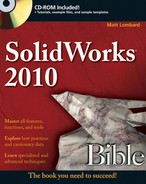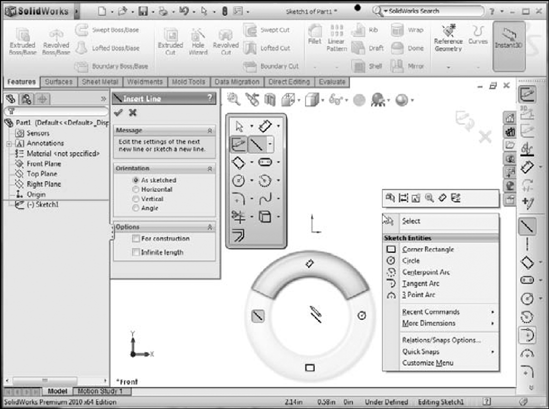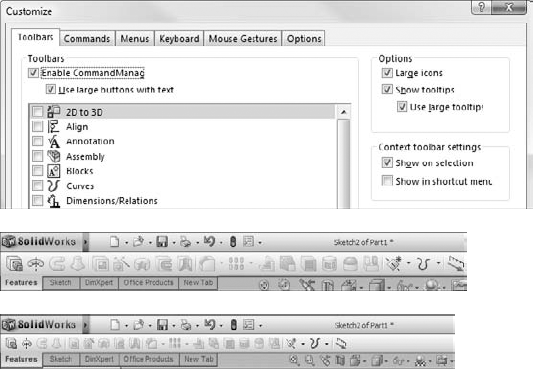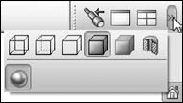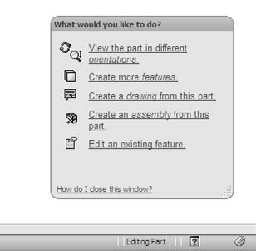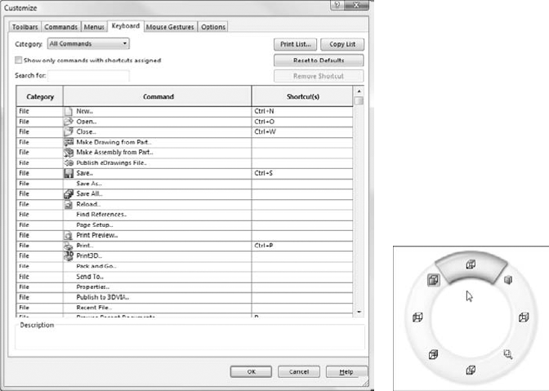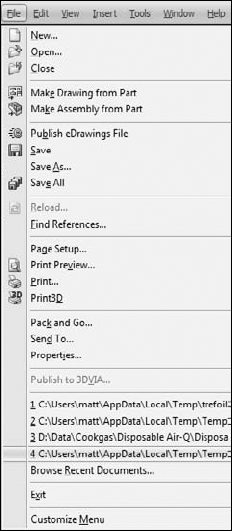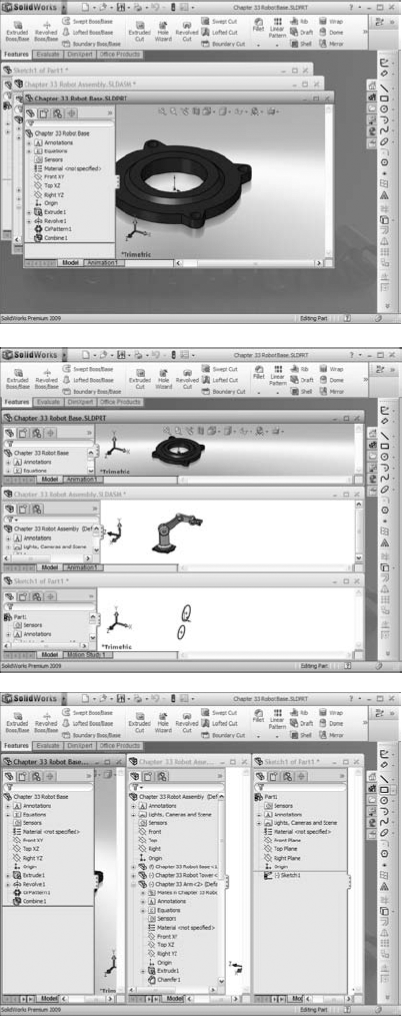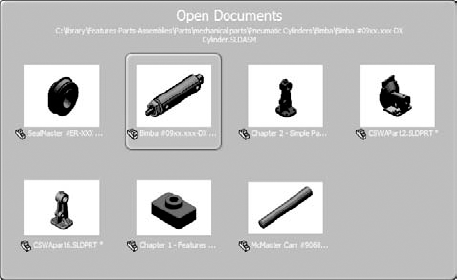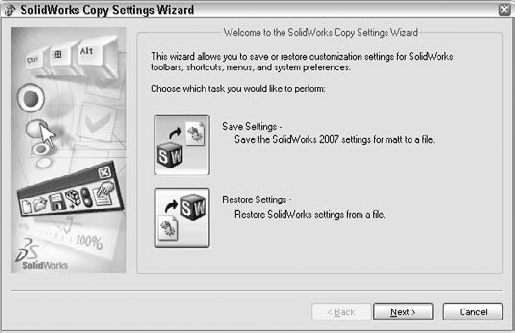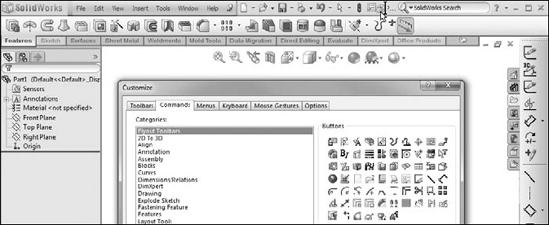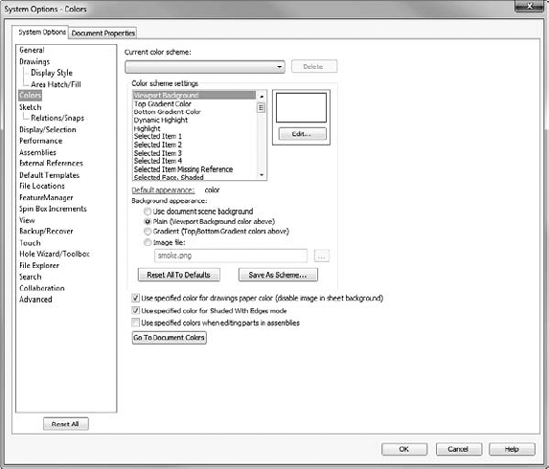The SolidWorks interface offers a wide range of tools. You will often find more than one way to do almost everything. There is no one best way to use the interface; and each method has strengths and weaknesses depending on the task.
Once you have mastered the various interface elements and customized your SolidWorks installation, working with the software becomes much more efficient and satisfying. You may find your mastery of the interface comes with practice and experience. The interface is complex and can be daunting. Many existing users may discover features in this book of which they were not aware, even though they have been trained and have used the software for years.
I explain each interface element identified in Figure 2.1 in detail within this chapter.
The major elements of the SolidWorks interface are the graphics window, where all the action takes place, the FeatureManager, which is the list of all the features in the part, the PropertyManager, where most of the data input happens, and the CommandManager and toolbars, where you access most of the commands in the software. Of these, I cover the CommandManager and toolbars first.
In some respects, the CommandManager resembles the Microsoft (MS) Ribbon interface found in Office 2007 applications. SolidWorks did not do a strict implementation of the MS Ribbon, because it wanted to add more customizability. A far more complete array of interface configuration possibilities awaits you with SolidWorks 2010. In this section of the chapter, I show you how to make the 2010 CommandManager work for you, and how to use regular or flyout toolbars to replace it effectively.
The CommandManager is an area of the interface that you can use to save space traditionally used by toolbars. The main mission of the CommandManager is to enable you to have easy access to all toolbars, and even access to customized groups of icons not available on a single default toolbar, without cluttering the entire screen with toolbars.
The CommandManager accomplishes this by providing small tabs under the left end of the toolbar area to enable you to switch the toolbar that appears. Figure 2.2 shows the CommandManager in customize mode, showing all the tabs available in a default setup. To get the CommandManager into customize mode, right-click one of the CommandManager tabs and select Customize CommandManager. Alternatively, you can choose Tools
Note
To access the pull-down menus in a default setup, place the cursor over the SolidWorks logo or the small flyout triangle to the right of it in the upper-left corner of the SolidWorks window. Figure 2.2 shows the flyout for pull-down menus. To keep the menu in that position, click the pushpin on the right end of the flyout menu bar.
Notice the last tab along the bottom of the CommandManager on the right. If you want to add a custom tab, you can right-click this tab and select the tab you want to add. You can also select to add a blank tab and populate it with individual buttons. Figure 2.3 shows a detail of the Add Tab menu options after you right-click the tab.
You can also left-click the special tab on the right and skip the Add Tab menu. To add individual buttons, first find the button you want to add in the Customize dialog box by choosing Tools
In SolidWorks, you can undock the CommandManager and leave it undocked, pull it to a second monitor, or dock it vertically to the left or right. To undock it, click and drag on any non-toolbar button area of the CommandManager, such as around the border. To re-dock an undocked CommandManager or to change its docking location, drag it onto one of the docking stations around the screen. Figure 2.4 shows the CommandManager undocked.
The small box with the arrows in it in the upper right-hand corner of the undocked CommandManager and the undocked PropertyManager is the Auto Collapse option. Early versions of SolidWorks 2010 seem to have some inconsistencies in the way this option works with PropertyManagers. You may have to resize detached PropertyManagers manually for various features. When the option is active, the PropertyManager expands and collapses automatically, and should not require scroll arrows unless the PropertyManager is larger than your monitor's height. In the condition it is shown in Figure 2.4, the undocked CommandManager will not collapse, but if you click Auto Collapse, the arrows go away, and the entire CommandManager acts like a big fly-out toolbar. This can be very handy because it saves a lot of space on the screen, but at the same time, it requires additional mouse movement to open it up. This is the common trade-off in this interface —you can trade screen space for additional mouse movement or clicks.
To put a toolbar inline with the CommandManager, drag the toolbar close to the CommandManager. A space on that row or column will open up. The amount of space that opens up depends on the tab with the longest set of icons, even if that tab is not showing. To increase the amount of space available for a toolbar on the same row as a CommandManager, enter Customize CommandManager mode by right-clicking a tab and selecting Customize CommandManager. Then cycle through the available tabs, looking to see which one has the most icons. Remove icons from the tab with the most. This makes more room for toolbars to the right of the CommandManager.
SolidWorks remembers which tabs to show on a per document type basis. This means that when you are working on a part document, you will have one set of tabs. When you switch to an assembly document, you will see a different set of tabs. The same goes for drawings. Notice that in Figure 2.3, in the right mouse button (RMB) menu, the options Copy Tab to Assemblies and Copy Tab to Drawings appear. These options make it easier to set up customizations that apply for all document types.
For an element of the interface that is supposed to save space, the default settings for the CommandManager sure take up a lot of it! When many users see the CommandManager for the first time, they ask how to deselect the text.
You can deselect the text in one of two ways. The easiest way is to right-click in the CommandManager and deselect the Use Large Buttons with Text option, as shown in Figure 2.5.
Another way to remove text from the CommandManager is to remove it only from selected icons. To do this, first enter the customize mode by choosing Tools
Notice also that the text by default goes to the right side of the icon, but using the RMB menu, you can put the text beneath the icon. With these options and some patience to go through the entire interface, you can almost totally customize the appearance and function of your CommandManager.
The most streamlined and space-efficient way to set up the CommandManager is to deselect the text. This arrangement is shown in Figure 2.5, in the lower image. Notice that the CommandManager without text takes up the same amount of height as a normal toolbar, with the added room for the tabs at the bottom. The text can be useful for new users or features that you do not commonly use. Also, notice that with the text turned off, you have room for more toolbar space at the end of the CommandManager.
The final setting for the CommandManager appearance is the size of the icons. You have control over the size of the icon images in the CommandManager. You can find this setting in the Customize dialog box (Tools
This setting applies to all the toolbar icons except the Menu Bar, RMB menu, and Context Bar icons. The setting does apply to the S shortcut toolbar and the Heads-up View toolbar, which I discuss later in this section. Large icons can be useful on displays with very high resolution, in particular on laptops where the screen itself may be small but the resolution is very high. All the screen shots in this book are taken with the Large Icons option selected for improved visibility. There is often a small difference between the appearance of the large and small icons.
If you undock the CommandManager, you cannot reorient the tabs horizontally. They remain vertical. In addition, you cannot place multiple rows of toolbars on the same row as a CommandManager using large buttons with text. In addition, you cannot dock the CommandManager to the bottom of the SolidWorks window. Another minor limitation is that although SolidWorks enables you to place toolbars at the right end of the CommandManager, it does not allow you to place them to the left of the CommandManager.
The point of the CommandManager is to enable you have many toolbars available to you in a single click, with the main goal being space savings. SolidWorks is a complex program, with a sprawling interface. The CommandManager does a good job of making most of it available to you quickly without taking up a lot of space. Unfortunately, when you save one thing, you usually wind up giving up something else. Interface set up is frequently about compromise or balancing conflicting concerns. In the case of the CommandManager, the compromise is between mouse travels and clicks. You may find yourself clicking frequently back and forth between the Sketch and Features tabs. For this reason, in my interface setup, I put the Sketch toolbar vertically on the right, and remove it from the CommandManager. This enables me to see the Sketch and Features toolbars at the same time, and greatly reduces the times I have to click back and forth between the tabs.
You can enable and disable toolbars in several ways. To enable a toolbar, right-click in a toolbar area and you will be presented with a list of toolbars in SolidWorks. You can enable and disable this list from here. Another way to do this is to use the Customize dialog box by choosing Tools
The Heads-up View toolbar appears along the middle of the top edge of the graphics window. Figure 2.8 shows the default arrangement of the Heads-up View toolbar, and it is shown in relation to the rest of the interface in Figure 2.1.
You can customize the Heads-up View toolbar by using the Toolbars dialog box (Tools
Cross-Reference
Chapter 3 covers the Confirmation Corner in more detail.
The Menu Bar toolbar is found just to the right of the SolidWorks logo on the title bar in the top left corner of the SolidWorks window. By default, it contains most of the elements of the Standard toolbar, and it is available even when no documents are open. It uses mostly flyout toolbar icons, so again it follows the trend of saving space at the expense of an extra click. This toolbar can be customized in the same way as normal toolbars in the Customize dialog box in the Commands tab. This toolbar cannot be turned off, but you can remove all the icons from it.
Note
You could run the SolidWorks interface from just the CommandManager without any additional toolbars; you could do the same with just the Menu Bar toolbar, customizing it with all flyout toolbars. The main advantages of this toolbar are that it is visible when no documents are open, and that it makes use of otherwise wasted space in the title bar. You might set up the interface for a 12-inch normal aspect display laptop very differently from that of a desktop unit with a 24-inch wide screen.
There is also a Menu Bar Menu, which is hidden by default. The SolidWorks logo in the upper left of the SolidWorks window or the small triangle next to the logo serve as a flyout to expand the main SolidWorks menus. You can pin the menus in place using the pushpin shown at the right end of the menus in Figure 2.9. When the menu is pinned, the toolbar moves to the right to accommodate it.
Note
The 3Dcontrol menu entry is not part of base SolidWorks; it is part of the 3Dconnexion (spaceball) driver.
Notice that on low resolution or non-maximized SolidWorks windows, you can run into some space problems if the Menu Bar Menu is pinned open. The SolidWorks window in Figure 2.9 is the SolidWorks 2010 interface with all default settings displayed at 1024 × 768 resolution, which is a common resolution when using digital LCD projectors or small notebook computers. You need to examine the changes in the SolidWorks interface with display size in mind. You might consider having different sets of settings for using a laptop at a docking station with a large monitor, using the laptop with a small monitor, or using the computer with a low-resolution digital projector.
SolidWorks has implemented flyout toolbars that save space by putting several related icons on a flyout. For example, the Rectangle tool has several different ways to make a rectangle, with a tool for each, and they are all on the rectangle flyout.
You can see all the available flyouts in the Customize menu (Tools
The purpose for flyouts is primarily to save toolbar space when several tools are closely related. SolidWorks has set up flyouts in two configurations: fly-outs that always maintain the same image for the front button (such as the Smart Dimension fly-out) and fly-outs that use the last used button.
Toolbar flyouts are listed in Tools
Add-in flyouts, such as the FeatureWorks flyout, are controlled by that specific add-in and again keep the same icon always on top.
The flyouts used for tools of similar function are split between using the most recently used tool icon on top and keeping a consistent icon on top. The only tools that appear to follow the latest icon method are the Sketch Entities tools. Sketch tools and other flyouts use a hard-coded top image.
Context toolbars are toolbars that appear in the graphics window when you right-click or left-click something. When you right-click, a context toolbar appears at the top of the RMB menu, and shows the functions that SolidWorks deems the most commonly used functions. This is a static list, and does not change as you use the buttons. These functions are removed from the RMB menu and replaced with the Toolbar icon in a toolbar above the abbreviated RMB menu, as Figure 2.10 shows.
An identical toolbar appears when you click an item on screen. When this toolbar appears with a left-click, the rest of the RMB menu does not appear. Tool tips are available if you do not recognize the icons on the toolbar.
For reference, the icons in the context toolbar atop the RMB menu (the icons without text) shown in Figure 2.10 are in order from the upper-left: Edit Feature, Edit Sketch, Suppress, Rollback, Select Other, Sketch, Hide Body, Zoom To Selection, Normal To, and Appearance Callout. Notice that these selections do not reappear in the main RMB menu.
These context toolbars are not editable, but you can turn them off, and put the RMB menus back to a familiar configuration. To deselect, click the context toolbar and choose Tools
I find that the RMB context toolbars are distracting because they force you to read a two-dimensional list of icons and a one-dimensional list of text. To me, this is just too confusing. I turn these off so that the RMB menus look like they always did.
However, I do find left-click context toolbars useful for things like Hide Sketch, Edit Feature, Edit Sketch, Appearance Callout, sketch relations, and so on. When I use the RMB menus, I'm looking for a more general function. When using the left-click context bars, I'm looking for something specific that I know is there. In Figure 2.11, the Show on selection check box option simply refers to the left click toolbar, and Show in shortcut menu check box option refers to the RMB menu.
The purpose of the context toolbars is to save space by condensing some commands into a toolbar without text instead of a menu with icons and text. The left- and right-click toolbars are the same, but they work differently. The left-click context toolbar fades as you move the cursor away from it and becomes darker as you move the cursor toward it. Once it fades past a certain point, you cannot get it back, except if you have Ctrl+selected multiple entities. The context toolbar does not appear until you release the Ctrl key. To get a context menu to show up again after it has faded, you can just move the cursor back to approximately where the toolbar would have been and press Ctrl again. This works only for multiple selection menus where Ctrl was used to multi-select. The functionality is probably a bug, or unintentional in any case, or else it would also work somehow for single selections.
The Shortcut toolbar is also known as the "S" toolbar because by default you access it by pressing the S key. You can customize this toolbar for each document type and another for sketches, so it can have different content for sketches, parts, assemblies, and drawings. To customize the "S" toolbar, right-click it when it is active and click Customize from the RMB menu, as shown in Figure 2.12.
Many people claim to have customized the "S" toolbar to such an extent that they have been able to remove the CommandManager and all other toolbars from their interface. This is possibly true if you use a limited number of sketch entities, sketch relations, and feature types, or make extensive use of flyouts on the "S" toolbar. However, if you work with a wide range of tools (say, surfacing, sheet metal, and plastic parts), you may need some additional toolbar space. It is completely believable to have access to most of the software's function with the "S" toolbar and either the Menu Bar toolbar or the CommandManager. CommandManager by far gives you the most flexibility, but it also requires the most space.
The S key shortcut may conflict with another keyboard customization you have done, depending on how your software was installed. To change the "S" toolbar key to another character or to reassign it, follow the directions for creating and maintaining hotkeys later in this chapter in the section on customization. It is referenced as the Shortcut Bar in the Keyboard list (Tools
Tool tips come in two varieties: large and small. Large tool tips show the name of the tool, along with a brief description of what it does. Small tool tips show only the tool's name. To change the tool tip display from large to small, or to deselect the tool tip display altogether, choose Tools
Note
The Customize option (Tools
After all that, if you still feel you need to work with standard toolbars, it is easy to move, select and deselect, and add icons to toolbars. It is important to remember that different document types retain different toolbar settings; for example, the toolbars that you see with a part open are different from the toolbars that you see for drawings.
When you are working on parts, it is important to have both the Sketch and the Features toolbars active. When you are working on a drawing, you will never use the Features toolbar, but you will frequently use the Sketch toolbar. Likewise, for assemblies, you may want to display some additional toolbars and eliminate others. For this reason, when you change from a part document to a drawing document, you may see your display adjust because the changing toolbars increase or decrease the amount of space that is required.
Best Practice
It is best practice to set up the toolbars for each document type so that they take up the same amount of space — for example, two rows on top and one column to the right. This way, changing between document types is not so jarring, and the graphics area does not need to resize for each change.
To move a toolbar, you can click with the cursor at the dotted bar on the left end of the toolbar, as shown in Figure 2.14. The cursor changes to a four-way arrow and you can then drag the toolbar where you want it. Toolbars dock either vertically or horizontally. You can resize undocked toolbars so that they have rows and columns. This arrangement is typically used with the Selection Filter toolbar, which is often left undocked and compressed into a block that is three or four columns wide.
If the SolidWorks window is not wide enough for the toolbar to fit entirely in the screen, double arrows like those shown in Figure 2.15 appear at the end of the truncated toolbar. When you click the double arrows, a flyout toolbar appears with the missing icons, as shown in Figure 2.16.
You can use any toolbar as a flyout toolbar. Figure 2.17 shows the list of all flyout toolbars, which is the same as the list of all toolbars. Flyout toolbars are a nice space-saving feature for tools that you use infrequently, but frequently enough to want to avoid going through the menus. To use a toolbar as a flyout, select it from the Flyout toolbars list and drag it onto an existing toolbar. It displays with an arrow to the right. Clicking the arrow causes all the tools to scroll out temporarily until you click a toolbar icon or anything else.
To add icons to a flyout toolbar, temporarily show the regular toolbar that corresponds to the flyout toolbar and add icons to the regular toolbar. When you are done adding or removing icons, deselect the regular toolbar; the changes are applied to the flyout.
Tip
If you want to create a separate toolbar, you can commandeer an existing one for your own purposes. For example, because I do not use the Tools toolbar, I have removed all the regular icons from it and replaced them with relevant flyout toolbars, which I do use extensively. This enables me to consolidate space, and not have unused icons on my toolbars. Alternatively, creating a custom CommandManager tab and putting on it what you like is much easier.
Full Screen mode enables you to toggle quickly to the display so that only the graphics window and the Task pane appear; the FeatureManager, menus, toolbars, and status bar are all hidden. Alternatively, you can hide just the FeatureManager or the toolbars.
In Full Screen mode, you can still access the menus by clicking the cursor along the top border of the window, as shown in Figure 2.18.
To toggle to Full Screen mode, press the F11 key.
To toggle the toolbar display, press the F10 key (see Figure 2.18).
To toggle the FeatureManager display, press the F9 key.
When you first install and run the SolidWorks software, the SolidWorks Welcome screen shown in Figure 2.19 offers you the option to customize the interface using one of three preset option packages. Special menu and toolbar settings are made for Consumer product design, Machine design, or Mold design. After the software is initially installed, you only see this screen once, but you can change all the options in other places, including the Options tab in the Customize dialog box.
The three-workflow customizations affect the interface as follows:
Similar changes are made to the menus to hide or show menu selections as appropriate. You can find more information about hiding and showing menu items later in this chapter.
If you want to select a different option after the initial setup, choose Tools
Everyone has his own style of working. For example, some people like to use menus and others do not. Some like to use hotkeys and others like the mouse. Modify Section View is an example of a tool that you cannot access via toolbars. It can only be accessed via the menus.
The most frequently used menu items are in the View, Insert, and Tools menus. All the menus shown in this section have all the possible options selected. As a result, the View menu in Figure 2.21 may contain options that are not available on your computer. Customizing menus is covered later in this chapter. Figure 2.21 also shows the Insert and Tools menus, along with an image of a menu with the Customize Menu mode activated.
You use the View menu primarily for turning on or off the visibility of entity types such as planes, sketches, or temporary axes. You can also do this by using hotkeys or by putting extra items on the View toolbar.
The Insert menu is used mostly for creating feature types for which you do not have a toolbar icon on the screen. For example, although the Move Face tool is on the Mold Tools toolbar, it has many uses aside from mold design. You can find the Move Face tool by choosing Insert
The Tools menu is used primarily for sketch entities or tools for which you have no icon on the screen. Several other commonly used tools, such as Measure, Equations, Customize, and Options, are also available in this menu.
You can customize menus by adding or omitting items. By using the Customize Menu option at the bottom of any menu — including shortcut (RMB) menus — you can remove items from any menu by clearing the check boxes next to tools that you do not use. To bring back the removed items, you can either go back to the Customize Menu or choose Tools
Note
Be careful not to confuse this Customize Menu selection with the Customize menu selection on the Tools menu. Figure 2.21 shows the Tools menu being customized. In addition, I do not recommend removing items from the menus. It doesn't take much for someone to need one of those items and no one remembers that it was supposed to be there or how to get it back.
The Options dialog box (Tools
SolidWorks cursors are context sensitive, and change their appearance and function depending on the situation. Sketching cursors display a pencil and the type of sketch entity that you are presently sketching. Sketch cursors also display some dimensional information about the entity that you are sketching, such as its length or radius. Sketch cursor feedback is necessary for fast and accurate sketching.
To learn more about sketch cursor feedback, see Chapter 3.
The Select cursor changes depending on the item over which you have positioned it. Cursor symbols also help remind you when selection filters are active. The cursor is frequently available as an OK button. For example, after selecting edges for a Fillet feature, the RMB functions as an OK button. Figure 2.22 shows various cursors and their significance.
The FeatureManager window is the panel to the left of the screen, which shows an ordered list of features describing how the part was built. SolidWorks users spend a fair amount of time using the FeatureManager to edit or inspect models. Figure 2.23 shows the FeatureManager for a simple model.
One of the benefits of putting dialog boxes in the PropertyManager is that it saves a lot of space on the screen. On the other hand, you will often need to make a selection from the FeatureManager at the same time that the PropertyManager pops up and takes its place. You can disable this automatic pop-up behavior by choosing Tools
My favorite option for dealing with the PropertyManager is to detach it from the FeatureManager so that you can see the two side by side instead of one or the other. To detach the PropertyManager, drag its icon from the tabs out into the graphics area and release. Once the PropertyManager is detached, you can move it to a second monitor, float it within the SolidWorks window, or dock or reattach it. To put it back in its place under the FeatureManager, just drag it back on top of the FeatureManager using one of the docking station symbols on the screen, allow it to snap into place, and release it.
If you do not like the detachable PropertyManager, you can use the splitter bars either to put the FeatureManager on top and the PropertyManager beneath, or use the flyout FeatureManager. When creating or editing a feature, you can access the flyout FeatureManager by double-clicking the name of the feature at the top of the PropertyManager. The flyout FeatureManager is displayed just to the right of the regular FeatureManager, in the main graphics window, and is transparent to enable you to see the model through it. The various ways of combining the FeatureManager and PropertyManager are shown in Figure 2.24.
By default, the Task pane sits to the right of the SolidWorks screen, although you can undock it entirely. If you want to keep it open, click the pushpin in the upper-right corner of the pane. The Task pane is shown in Figure 2.25.
The Task pane is the home for several panels:
SolidWorks Resources. These are useful links for templates, tutorials, tech support, news, GlobalSpec search, Tip-of-the-Day, and other resources.
Design Library. This includes locally stored libraries, Toolbox, and 3D Content Central. This tab also contains "SolidWorks Content," which consists of additional library resources that can be downloaded directly from the Task Pane.
File Explorer. This is a Windows Explorer interface that you can use to browse for files.
SolidWorks Search. If you have installed the Windows Desktop Search with SolidWorks 2010 and indexed your files, you can perform searches that include filename and custom properties.
View Palette. This palette enables you to visually select views and drag them onto a drawing sheet.
RealView. This panel enables you to select appearances and scenes for your SolidWorks documents.
Custom Properties. The custom property tab in Task pane enables you to create a custom interface that goes inside this Task Pane tab that will help you enter custom property data quickly, easily, and accurately.
Recovered Documents. After a crash, auto recovered documents are listed in this special purpose Task Pane tab.
The status bar is a non-intrusive way in which SolidWorks communicates information back to the user. It is located at the bottom of the screen, and you can enable it from the View menu. Figure 2.26 shows the status bar in action.
The status bar can display the following information, indicators, and icons:
Progress as parts, assemblies, or drawings load
Tool tips for commands
Measurements
The sketch status for an active sketch
In-context editing
Suspend automatic rebuilds
The sheet scale for drawings
The cursor position for drawings and sketches
Whether you are editing the sheet, sheet format, or view of a drawing
Tags work like document properties, except that they do not need a property name; they just use a value. A tag could be considered simply a keyword that you can associate with a part in an assembly or even a feature in a part. Tags can be searched by SolidWorks Explorer or by the FeatureManager Filter. You can assign tags by clicking the yellow tag icon on the status bar in the lower-right corner of the SolidWorks window. Figure 2.27 shows a tag being added to a feature.
Quick Tips appear in the pop-up window in the lower-right corner of the graphics window. They can change as you work so that they are sensitive to the context in which you are working. They are a great way for new users or infrequent users to learn or be reminded of the next steps available to them. You can activate and deactivate Quick Tips by clicking the question mark icon in the lower-right corner of the SolidWorks window on the status bar. Figure 2.28 shows the Quick Tips window in action.
This is a tool specifically for people who are coming to SolidWorks from AutoCAD. As the name suggests, it adds a command line to the bottom of the SolidWorks window that works like the AutoCAD command line in most respects. The available commands are somewhat limited compared to those that are available in AutoCAD. This tool only functions in the 2D sketch mode, on a drawing sheet, or in a drawing view; it does not work in a 3D sketch. The 2D Command Line Emulator is shown in Figure 2.29.
Available sketch tools in the 2D Command Line Emulator include Align, Arc, Array, 'Cal, Chamfer, Chprop, Circle, 'Color, Copy, DDcolor, Dim, Dist, Ellipse, Erase, Exit, Extrude, Fillet, 'Grid, Line, List, Massprop, Mirror, Move, Offset, 'Ortho, 'Osnap, 'Pan, Plot, Point, Polygon, Qsave, Rectangle, 'Redraw, 'Redrawall, Revolve, Rotate, Save, Saveas, 'Snap, Spline, Trim, U (undo), 'Units, 'View, and 'Zoom. You can use commands preceded by an apostrophe (') as transparent commands without exiting an active command. Notice that even the cursor changes to crosshairs.
Best Practice
The best way to learn a new software package is to embrace the new way, not to cling to the old way. Although AutoCAD users may find the 2D Command Line Emulator more comfortable to work with, you will not achieve the same results, as you will with the SolidWorks default-sketching mode. For example, the resulting sketch entities created using the 2D Command Line Emulator are not constrained in any way, and the endpoints do not even merge. You can deselect the 2D Command Line Emulator by going to Tools
Note
The 2D Command Line Emulator is not available on 64-bit computers.
As engineers and designers, we all like to tinker with things to optimize efficiency and to apply our personal stamp. When the SolidWorks software is installed, the interface is functional, but not optimal. In the previous pages, I have discussed managing and customizing toolbars and menus. In the remainder of this chapter, I focus more on customizing the interface, and suggest some strategies that you might use to help customize your work environment.
You need to be aware of a few things before you change the standard colors in the SolidWorks interface. The first is that SolidWorks does not automatically alter text color to contrast with your background. As a result, if you set the background to black, and the text is black, you won't be able to see the text. This may seem obvious to some people, but AutoCAD automatically changes text color to contrast with the viewport background, and so AutoCAD users may take this functionality for granted.
All the interface colors are controlled in the Systems Options Colors dialog box. You can access the dialog box by choosing Tools
Notice that you can set a color scheme. I recommend that if you want to change the colors used in the interface, you save the settings as a color scheme so that the scheme can be re-created easily later or handed off to another computer. Color schemes are stored in the Windows registry, not as separate files. To transfer color settings to another computer, you will need to either use the Copy Settings Wizard or manually copy data from the Windows registry.
Before making changes, you might consider saving your initial settings as a separate scheme so you can get back to them if you need to.
Warning
Making changes to the Windows registry can adversely affect software installation and hardware performance. You should not attempt changes to the registry unless you know exactly what you are doing.
You should avoid some colors for the background, or you should make some changes if you choose these colors. Black is used with fully defined sketches, dimensions, FeatureManager text, and annotations. Blue can mask the underdefined sketch color. Bright green (or blue, depending on the version you are using) can cause problems with seeing selected items. Bright red, aside from being a terrible color to stare at all day, also does not contrast well with some of the red highlights and error colors.
You might think that no matter which color background you select, aside from the default, the items or features are difficult to see. For this reason, many users choose a gradient background, which enables them to pick colors where items are always visible on one-half of the screen or the other. Staring at a white screen all day can be uncomfortable for your eyes, so pick colors that enable you to see everything with "reasonable" contrast, yet are not glaringly bright. Very high contrast is hard on the eyes, and low contrast may make it difficult to distinguish items on the screen.
You have to consider what the purpose of the background is. Some people doing presentations may want the background to be attractive while otherwise staying out of the way. Others may only need the background to contrast with whatever is in front of it in a way that does not strain anyone's eyes. For writing a book, the background generally needs to be white to match the page. No one scheme will suit all needs.
In addition to colors and gradients, you can use an image as the graphics window background. This gives you a wider range of customization capabilities, and several sample images are already available in the default settings. Also, be aware that document scene backgrounds are document specific and override system options.
RealView also adds some capabilities with scenes. Scenes can be applied from the RealView tab on the Task Pane. RealView offers three different types of scenes: Basic, Studio, and Presentation. Of these, I find the Studio scenes to be the best when I need something with a reflective floor with shadows, otherwise I stick with the Basic scenes. I describe RealView, along with scenes, in more detail in Chapter 5.
You can easily customize many aspects of the SolidWorks interface, including:
Whether or not you should customize each of the previous items depends partially on how much time and energy you have to spend, as well as how much money you are ready to dedicate in the case of custom programming.
Some of us old-timers prefer to use the keyboard instead of the mouse. If your hand-eye coordination is as bad as mine is, you may also choose this approach. I can type without looking at the keyboard, but when I use the mouse, it takes me a few seconds to aim at an icon and hit it accurately. This means that I customize SolidWorks to use as many hotkeys as possible, and remove icons from the interface if I have them on hotkeys. Unfortunately, my memory is as bad as my eyesight, and so remembering 75 hotkey commands is a bit of a problem. I admit to having a printed list of hotkeys taped to the side of my monitor. While I know that needing to read the list to find a particular hotkey defeats most of the purpose of using them in the first place, I just accept it as a learning aid. This is a self-solving problem, because the hotkeys that I use the most are the ones that I learn most quickly.
I generally do not advocate trying to standardize a hotkey scheme across multiple users, unless the users all agree to it. The underlying reason for writing this section is that everyone remembers things differently in the first place.
Any command that I use more than a few times an hour is worth assigning to a hotkey. I like to use alliteration when assigning keys to help with my faulty memory. The most frequently used commands are assigned single-letter hotkeys, and the less frequently used commands are assigned combinations. Thus, Tools Options is linked to O, Measure to M, Select Vertex to Shift+V, and Curve Projected to Ctrl+J (Ctrl+P is the Windows standard for the Print command). Other people like to group keys into easy-to-reach combinations; this is why the Q, W, A, S, Z, and X keys are often assigned first for right-handed mouse users.
Hotkeys are assigned and organized in the Keyboard dialog box (Tools
Because the list of commands is so long, a Search function is available, and a drop-down arrow makes only the commands from a selected menu visible. The list of commands is organized by menu name, and the menus are listed as they occur in the interface. Fortunately, on the Keyboard tab, SolidWorks enables you to sort, using the column headers to list the menus, commands, or hotkeys in alphabetical order, simply by clicking the column header. This is a highly usable interface, one of my favorite interface changes in the last several releases.
Starting in SolidWorks 2010, you can now customize and use a mouse gesture interface, shown in the second image of Figure 2.31. To make the interface appear, just drag the RMB slightly, about 14 inch. Once you get used to the interface, a drag of about 34 inch in a single motion will activate the commands.
Note
I have found that this interface works best when you have memorized the commands available at various positions around the donut.
You can establish the donut in four or eight segments; it comes set to four by default. You can also do the customization in the Customize dialog box (Tools
Mouse gestures will probably not replace hotkeys or the "S" toolbar, but they do add effective quick access for a few functions.
Moving between the mouse and the keyboard can be bothersome and time-consuming. In addition to the hotkey approach, you can use another keyboard method to save time. Many users become adept at using the Alt-key combinations to invoke menu items. Most menu items in Windows applications contain a single underlined letter.
To access a top-level menu, you can hold down the Alt key and press the underlined letter for that menu, and then just press an underlined letter in the menu to access specific commands. This technique enables you to navigate most of the interface without using the mouse. For example, to exit SolidWorks, instead of using the mouse to click the red X in the upper-right corner, you could press Alt+F, X. In Figure 2.32, you can see that the F in File is underlined, as is the X in Exit.
You may potentially run into conflicts when using Alt-keys. A combination of Alt + another keyboard key is a valid use of a hotkey combination. If you use any Alt hotkey combinations, it is likely that you have seen a conflict like this. In cases of conflict, the hotkey combination seems to gain priority over the Alt-key accelerator.
In order to maximize valuable space on the monitor, many SolidWorks users strive to minimize the number of toolbar icons on the screen, or confine them to two rows of toolbars. You can do this by using the CommandManager, flyout toolbars, the "S" toolbar, right-click toolbars, and hotkeys, and removing unused icons, as well as the other techniques discussed here.
Having an uncluttered workspace is definitely a plus, but having easy access to commands is the real purpose of an interface in the first place. You need to strike a balance between too much and not enough. The more kinds of work you do in SolidWorks, the more tools you will need to have available. If you only create relatively simple machined parts and drawings, you will need fewer tools available than someone who creates complex plastic part assemblies with rendering and animation.
If you have never used a Spaceball or equivalent view-manipulation device, you should consider it. They are wonderful devices and do far more than just spin the view. Most of the devices also have several programmable buttons that you can link to menu items. They can move drawing views, parts within assemblies, and even manipulate selected objects in other Office applications and Web browsers.
I have written portions of this book on a Tablet PC. A tablet might not be ideal for long periods of SolidWorks usage. However, I use it regularly for presentations and even modeling when I really want to get the feel of drawing a line by hand. The stylus is not quite as intuitive as a pencil, but it is less of an impediment to the tactile feel of actual drawings than a clunky mouse. Tablets are a great option when used in combination with the new touch functions in SolidWorks, such as mouse gestures.
The mouse gestures functionality is considered a tool well suited to a tablet interface, where flicking the stylus is easier than mouse clicking. This is a single touch technique, since the stylus typically adds only a single point of contact with the screen.
Multi-touch devices are still rare, especially in the CAD-enabled office, but they are becoming more widely available. In preparation for this future functionality that seems ideally suited to visual applications such as CAD and 3D, SolidWorks has added functionality to take advantage of these tools. Multi-touch Action Mappings, as the SolidWorks Help refers to them, are intuitive two finger motions that enable you to control the view for actions like:
Zoom in or out
Rotate
Pan
Roll
Zoom to fit
Right click
SolidWorks gave these special actions a new page in the Options dialog, shown in Figure 2.33.
Macros are short snippets of programming code that have a particular function. Most macros are small and intended for simple tasks that are repeated many times, such as changing selected dimensions to four decimal places or zooming the screen so that it is sized 1:1 (actual size). Macros may be recorded, written from scratch, or a combination where you record a particular action for use as a starting point and then embellish it manually from there. Recorded macros may not always record the parts of the action that you want to make into a macro, but you can edit them manually to include anything that you can program with VBA (Visual Basic for Applications), which is included with the base SolidWorks package at no extra cost.
To access macros by using hotkeys, follow these steps:
Make a folder in your SolidWorks installation directory called "macros."
Copy macros into this folder.
Start (or restart) SolidWorks.
Choose Tools
Customize Keyboard.
Keyboard.
Scroll to the bottom of the list under the Macros category and then assign hotkeys as you would for standard SolidWorks commands.
Whether you are skilled at writing or recording macros, or you are just using macros collected from other people, they can be huge time-savers and offer functionality that you would not otherwise be able to access.
Once you have set up your menus and toolbars, worked out all of custom colors, figured out your hotkey usage, and connected your macros, you don't want to lose these settings when you reinstall the software or move to a different computer. Another user may want to share your settings, or you may want to transfer them to your home computer (for modeling the new deck or the doghouse, of course). Fortunately, these settings are very portable.
You can use the Copy Settings Wizard to save these settings out to a file. Access the wizard by choosing Start
Note
You may need to have administrator access to your computer to apply a SolidWorks registry file.
The SolidWorks settings are actually Windows registry settings. The file that is saved by the wizard is just a registry file that has a different extension to prevent it from being applied too easily. Saved-out Windows registry files have a *.reg file extension, and you can integrate them into the registry by simply double-clicking them. If you are not familiar with the Windows registry, you should not make direct changes, because even small changes can cause serious problems with your operating system, installed software, or even hardware. The settings that are saved out by the Copy Settings Wizard are safe to transfer between computers. In order for the Copy Settings Wizard to work, you need to have Administrator-level access to your computer. The Copy Settings Wizard is shown in Figure 2.34.
You may sometimes have the luxury of working on a single part at a time, but more often, you will find yourself with several documents open at once. This is a common situation for most users. Fortunately, SolidWorks has several methods for dealing with "information overload," to help you sort through it all.
Like most Windows applications, SolidWorks can arrange the open document windows in one of several ways that are available through the Window menu (see Figure 2.35):
Cascade. Most useful for accessing documents that are to be edited one by one.
Tile Horizontally. Most useful for wide and short parts.
Tile Vertically. Most useful for tall, narrow parts, or documents where you want to compare items in the FeatureManager.
Arrange Icons. When windows are minimized to icons, this menu selection arranges the icons neatly, starting in the lower-left corner of the window.
The images in Figure 2.36 are meant to show the arrangement of the windows, not the content of the windows. Also, remember that you can use the F9 key to close the FeatureManager, the F10 key to remove the toolbars to create extra interface space when arranging several windows in the graphics window, and the F11 key to remove portions of the interface and enable you to work full screen.
You can use several techniques to change from one SolidWorks window to another. By clicking on the Window menu, you can view a list of open document windows (refer to Figure 2.35). You can then select the desired window directly from this menu. If more than a few windows are open, a More Windows option appears at the end of the list, as shown in Figure 2.37. Clicking this option brings up a separate window that enables you to select from the complete list. Press Ctrl+Tab to open the Open Documents dialog box (see Figure 2.37). This enables you to select the document visually that you want to open.
Additionally, by default the R hotkey opens the Recent Documents dialog box, similar to the Recent Documents list in the File menu. This can also be accessed via the File menu if necessary. The Recent Documents dialog box is shown in Figure 2.38.
By this point, you have learned quite a bit about all the tools involved in using the SolidWorks interface. In this tutorial, you get some hands-on practice at manipulating the interface. This tutorial is intended to reinforce the following skills:
Adding and removing toolbars
Adding and removing toolbar buttons
Adding and removing items from drop-down and RMB menus
Setting up the CommandManager
Setting up hotkeys
Linking a hotkey to a macro
Changing interface colors
Regardless of what your initial settings are, you do not want to lose them. Before you start to make changes to your system, you should save out the existing settings to a file from which they can be recovered. You can do this using the Copy Settings Wizard, as shown in Figure 2.39.
To use the Copy Settings Wizard, follow these steps:
Close SolidWorks.
Choose Start
Programs SolidWorks 2010
SolidWorks 2010 SolidWorks 2010 Tools
SolidWorks 2010 Tools Copy Settings Wizard.
Copy Settings Wizard.
Select Save Settings, and click Next.
Enter a location and a name for the file.
Select the items that you would like to save. For the purposes of this tutorial, make sure that the following options are selected: Keyboard Shortcuts, Menu Customization, Toolbar Layout, and All Toolbars.
Click Finish. Browse to the location where you saved the file and make sure that it is there.
You can set the interface back to the default settings using one of two methods. The first method, editing the Windows registry, may not be available to all users. It requires Administrator access to your computer and a good familiarity with Windows.
Warning
Editing the Windows registry can be dangerous if you make a mistake. Do not attempt this method is you have any doubts about what you are doing.
To set SolidWorks back to its default settings by editing the Windows registry, follow these steps:
Close SolidWorks.
Choose Start
Run.
Type regedit, and click OK.
Browse to
HKEY_CURRENT_USERSoftwareSolidWorksSolidWorks 2010or the appropriate folder for the version that you are using.To return all settings in SolidWorks to default, rename the entire SolidWorks 2010 folder to include "(old)" at the end of the filename.
Close the Registry Editor.
The folder is re-created when SolidWorks starts up again, and is populated with default values. If you need to get the previous folder back, you can delete the new one and rename the old one to remove the "(old)" from the name.
The second method, which is less risky but less complete, is to go to the main settings locations and use the tools provided to return settings to their defaults. Restart SolidWorks and create a new blank document (you cannot display the Customize dialog box without a document open). To access the resets for the interface, do the following:
Note
The menu reset is known to work improperly in version 2009 and prior. It is not clear if this will be fixed in the 2010 version. Fortunately, customizing menus is not a task you will frequently do, so resetting them to default is something you will do even less frequently.
Choose Tools
Customize Keyboard
Keyboard Reset to Defaults, and go to the upper-right area of the dialog box.
Reset to Defaults, and go to the upper-right area of the dialog box.
Choose Tools
Customize Options; there are three Reset to Defaults buttons along the left side of the dialog box.
Options; there are three Reset to Defaults buttons along the left side of the dialog box.
Now that you have restored the default settings, you can begin customizing the interface with the CommandManager. To do this, open a part document or create a new one, then click the RMB anywhere on the CommandManager, and deselect the Use Large Buttons with Text option, as shown in Figure 2.40. When you have done this, the check mark should no longer appear in front of the option.
Next, add some toolbars to CommandManager, as follows:
RMB-click the CommandManager tabs and select Customize CommandManager.
Click (left-click) the New Tab icon at the right end of the CommandManager tabs and select Surfaces, Sheet Metal, and Annotations. Deselect the Sketch tab by right-clicking it and selecting Hide Tab. The new tab icon is shown in Figure 2.41.
In the Customize dialog box, select the Large Icons option.
Turn the Sketch toolbar on, but not inside the CommandManager; use the Toolbars tab of the Customize dialog box. Dock the Sketch toolbar to the right side of the window.
Select the Standard Views toolbar and drag it to the right end of the CommandManager. Now drag a couple of buttons off it, such as the bottom, or left, or back views.
On the Commands tab of the Customize dialog box, select the Flyout toolbars entry, and drag any Flyout toolbars from the Customize dialog box to the Menu Bar toolbar. Figure 2.42 shows this step in action.
With the Commands tab of the Customize dialog box still active, click on the View Category.
Add or remove tools until this toolbar has the tools you want to use on it. If you want to deselect the Heads-UP View toolbar, activate the Toolbars tab in Customize, and de-select the View (Heads-Up) option.
Run your cursor over the main menu flyout and use the pushpin to pin the menu open.
Choose Tools
Customize Options and select both Show All buttons for Shortcut customization and Menu customizations. This removes the double arrows at the bottoms of RMB menus. This setting is shown in Figure 2.43.
Options and select both Show All buttons for Shortcut customization and Menu customizations. This removes the double arrows at the bottoms of RMB menus. This setting is shown in Figure 2.43.
While still in the Customize dialog box, change to the Toolbars tab and deselect the Context Toolbar Settings
Show In Shortcut Menu option to disable the right click context toolbar to put the RMB menus back to their pre-2008 state (all entries in menu use text).
Click and drag the PropertyManager tab (second tab from the left) from the FeatureManager, and dock it just to the right of the FeatureManager under the CommandManager tabs. The display should now look like Figure 2.44.
The small flyout in the lower-right corner of Figure 2.44 is the remainder of the Sketch toolbar that does not fit on the screen. This screen shot was taken on a 12-inch monitor with large icons at 1024 × 768 resolution. At such a low resolution, long toolbars do not fit on the screen, and the remaining icons are activated by the two small arrows at the end of the toolbar.
If you always do the same types of work, or more importantly, never do certain types of work, you might consider customizing some menus to remove items that you never use. Customization applies to both the main drop-down menus and the context-sensitive RMB menus. To customize a menu, follow these steps:
Choose Insert
Customize Menu. Note that Customize Menu is different from Customize.
Deselect the menu items Sketch from Drawing, DXF/DWG, Object, Hyperlink, and Picture (see Figure 2.45). Click anywhere outside the list to close it.
Click on the Insert menu to ensure that the deselected items have been removed.
Select Customize Menu.
Deselect Section View. Click anywhere outside the list to close it.
RMB-click the Right plane to verify that Section View has been removed.
This tutorial does not depend on RealView capabilities, but later work will. To find out whether your computer is RealView capable, check your video card and driver version against the list on the SolidWorks Web site. On the main page of the site, follow the link for Video Cards.
Before starting this tutorial, make sure the RealView icon is disabled. You can deselect RealView by choosing View
Cross-Reference
For more information on RealView graphics, see Chapter 5.
Edit the colors used in the interface:
Choose Tools
System Options Colors. Make sure the "Plain (Viewport Background color above)" option is selected.
Colors. Make sure the "Plain (Viewport Background color above)" option is selected.
Change the Viewport Background color, first in the Color Scheme Settings list, to a light gray color, then click OK and make sure the setting was applied.
Return to the Colors dialog box by choosing Tools
System Options Colors, click the Save As Scheme button, and save the color scheme as Plain Gray.
Colors, click the Save As Scheme button, and save the color scheme as Plain Gray.
Now select the Gradient option, and select the top and bottom gradient colors (second and third in the top list). Click OK and see how you like the gradient display. Adjust the colors until you are happy with them.
Return to the Colors dialog box by choosing Tools
System Options Colors, click the Save As Scheme button, and save the color scheme as Gradient. Figure 2.46 shows the Colors dialog box.
Colors, click the Save As Scheme button, and save the color scheme as Gradient. Figure 2.46 shows the Colors dialog box.
Use the Current color scheme drop-down list at the top to change the color schemes between the newly saved schemes.
For many users, hotkeys are an integral part of the everyday experience of using SolidWorks. You can easily assign hotkeys and manage the assignments by following these steps:
Choose Tools
Customize Keyboard.
Keyboard.
In the Search For text box, type Options.
Click in the Shortcut column, and type O.
Click again in the Search For text box, and type Customize.
Click in the text box next to the Tools
Customize entry and press Ctrl+C. Click No to the question of whether you want to reassign the hotkey. Press Ctrl+T instead.
Click OK to exit the Customize dialog box.
Press the O key to open the Options tab. Click OK to exit.
Press Ctrl+T to open the Customize dialog box. Click OK to exit.
Press Alt+F, and then click the Close button to exit SolidWorks.
The following steps show you how to link a macro to a hotkey:
On the CD-ROM
You can use the macro called rectangle.swp, located on the CD-ROM.
Find your SolidWorks installation directory. By default, this directory is
C:Program FilesSolidWorks.Create a folder called Macros in the SolidWorks directory and put the rectangle.swp macro in it.
Open SolidWorks.
Create a new blank part document.
Press Ctrl+T to access the Customize dialog box.
Click the Keyboard tab.
In the Search For text box, type rectangle.
Click in the Shortcut column next to the listing with the Category of Macros, and press R.
Click OK to exit the Customize dialog box.
Press R. The rectangle macro runs and draws a sketch rectangle on the Front plane, centered on the origin.
Press Ctrl+S to access the Windows standard hotkey for the Save command. Name the part rectangle.sldprt and save it to a workspace directory.
Press Alt+F and then click Close to exit SolidWorks.
The use of Alt-keys and hotkeys is somewhat exaggerated in this tutorial, but it is intended to get you used to working with them.
The SolidWorks interface has many elements because SolidWorks has so much functionality. You can access most elements multiple ways, which can be liberating because it offers options, but it also can add to the confusion because there is so much to know. You do not need to know every way to do everything; you only need to know the best way for you. After using this book to find the various ways of using the interface, you can develop the way that is most comfortable for you and stick with it.
Be aware that every couple of releases, SolidWorks changes the interface, and often, they use the most radical options available as the new defaults. Keep a copy of your settings file with you, so you can restore settings or take your settings to another computer quickly if you need to re–set up.
